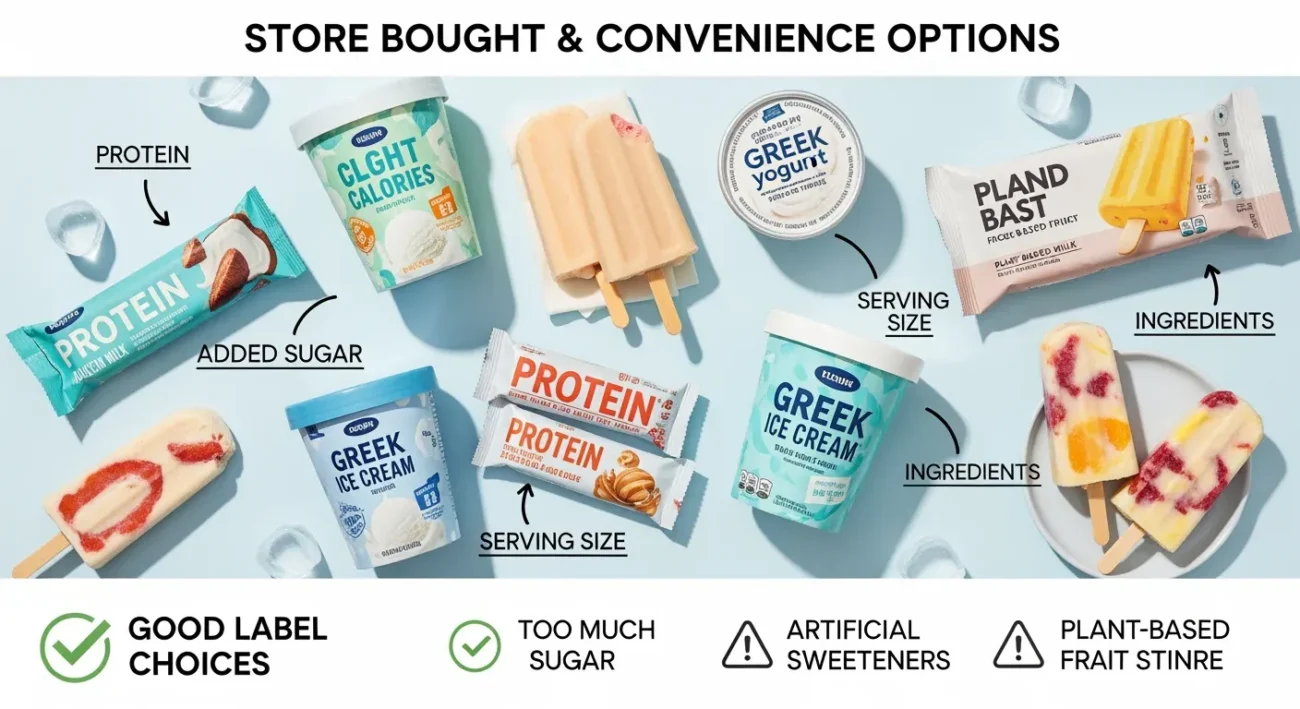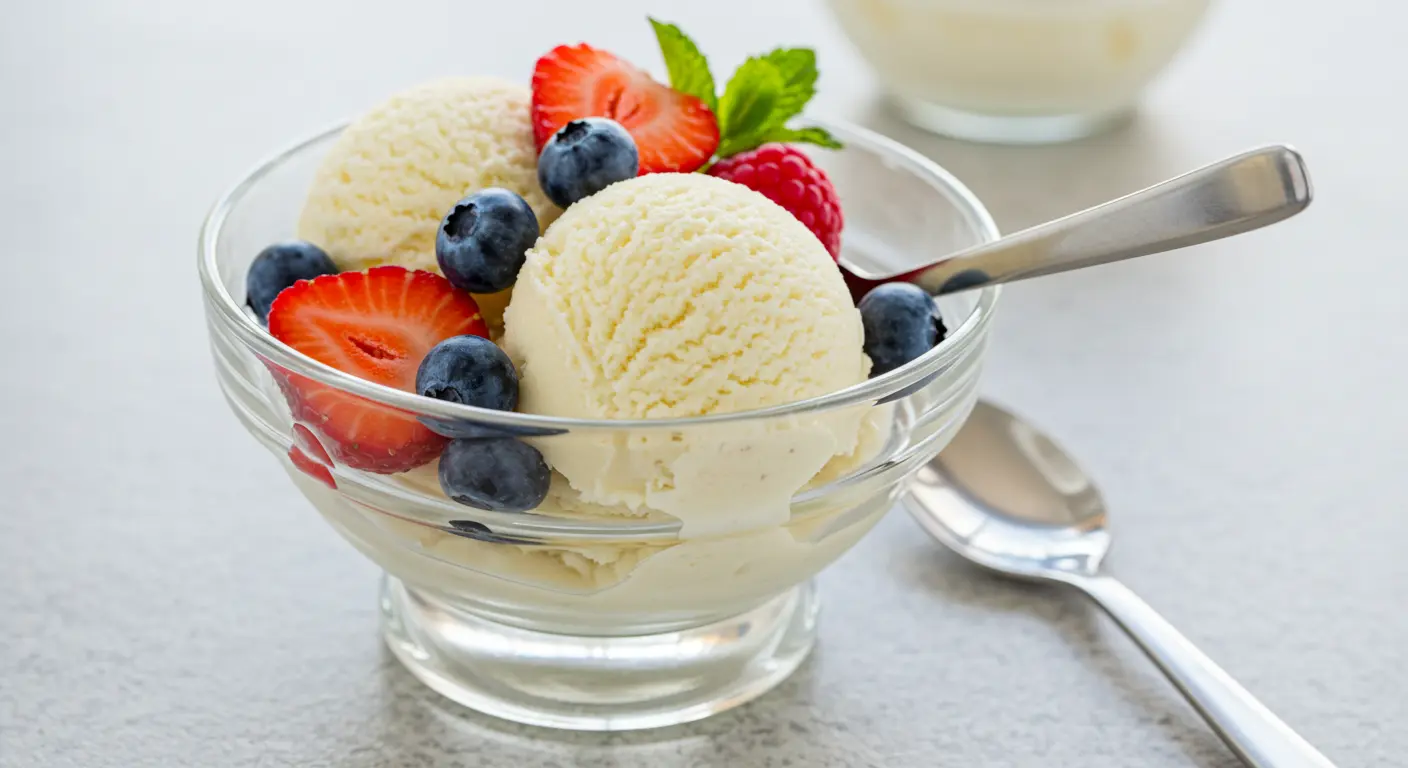Everybody loves ice cream. It’s creamy, sweet, cooling and usually, packed with calories. But what if you could enjoy a scoop (or two) and stay on track with your weight loss goals. That’s exactly what this post is for. I’ll walk you through what makes a “healthy ice cream,” give you recipes and store product tips.
What Makes an Ice Cream Healthy for Weight Loss
If you want to call an ice cream “healthy for weight loss” here are criteria to check. Think of these as filters when reading labels or crafting recipes.
Sugar (especially added sugar) must be moderate
Sugar adds calories but not much satiety. Try to pick ice creams with less than about 10 12 grams of added sugar per serving. If it’s fruit sugar (from berries, bananas), that’s better because there’s some fiber.
Protein Content
Protein helps you feel full, which can reduce overeating. Ice creams with Greek yogurt, protein powder, or milk solids boost the protein. A target of 5-10 grams protein per serving is good; more is even better, especially if it helps offset what the rest of your meal plan looks like.
Fat type & fat amount
Not all fats are bad, but full cream/double cream ice creams are very calorie dense. Go for lower saturated fat, or use healthy fats (nuts, avocados, some coconut). But be mindful: healthy fats still have calories.
Fiber & whole ingredients
If your base includes fruit, whole milk, yogurt, or nuts, you’ll get fiber and nutrients. Fibrous bits (fruit, nuts) also help slow digestion, so you stay full longer.
Portion size & calorie density
Even healthy recipes or light brands can sneak in many calories if your scoop is large. Use smaller portions aim for servings of about 120-200 calories, depending on your daily calorie goal.
Texture & satisfaction
If ice cream is icy, thin, or missing something you love, you might eat more to compensate. Texture matters: creamy, smooth, richness (without overdoing fat) keeps you satisfied.
Home Recipes & Hacks
Making your own lets you control everything. Here are recipes and tips you won’t always see elsewhere.
Banana Berry Protein Nice Cream
Ingredients:
- 2 frozen ripe bananas
- ½ cup (≈120 ml) unsweetened almond milk (or other plant milk)
- ½ cup mixed frozen berries
- 1 scoop vanilla protein powder (whey or plant-based)
- Optional: 1 tsp cinnamon or vanilla extract for flavour
Instructions:
- Slice bananas and freeze.
- Blend frozen bananas with almond milk until smooth. Add berries and protein, blend until creamy.
- Freeze for 30 minutes to firm up (if needed).
Macros (approx per serving, makes 2 servings): ~150 180 kcal, 7-10g protein, modest sugar (from fruit), healthy portion of fiber.
Greek Yogurt & Coconut Light Chocolate

Ingredients:
- 1 cup non-fat Greek yogurt
- ¼ cup light coconut milk (unsweetened)
- 2 Tbsp unsweetened cocoa powder
- Sweetener: 1-2 Tbsp of sugar substitute or honey (if you prefer)
- 1 tsp vanilla extract
Instructions:
Same method: mix everything, freeze, stir after an hour or so to break ice crystals, freeze until firm.
Hacks to Improve Any Ice Cream You Make
- Freeze the mixing bowl or canister beforehand helps texture.
- Add a little alcohol extract (vanilla, mint) or a touch of strong flavour (espresso) so you use less added sugar.
- Stir or churn halfway through the freezing process to avoid big ice crystals.
- Include small chunks of fruit or nuts at the end, so you get texture contrast without raising base calories too much.
Store Bought & Convenience Options

Not everyone has time or equipment. Here are tips to pick good store brands + a few examples.
What to look for on the label
- Serving size: make sure “serving” matches what you’ll eat.
- Added sugar vs natural sugar.
- Protein grams.
- Fat, especially saturated fat.
- Ingredient list: fewer, simpler ingredients, less artificial stuff.
Brands & Types to Try (depending on region)
- Light / low-calorie “light” ice creams.
- Greek yogurt-based frozen treats.
- “Protein ice cream” brands.
- Non-dairy / plant-milk based options (almond, oat, cashew), as long as sugar isn’t huge.
Beware of:
- Hidden sugar alcohols or artificial sweeteners that may upset digestion.
- Fat from coconut or cream that pushes calories high.
- Flavour hype (e.g., “double chocolate fudge”) with big sugar/fat costs.
Integrating Ice Cream Smartly into a Weight Loss Plan
Having healthier ice cream doesn’t automatically mean it won’t affect your goals. Here’s how to use it without derailing your progress.
Portion & Frequency
Limit to 1 small serving (say ½ cup or one-bar size) when you want it. Maybe 1-2 times per week depending on your calorie budget.
Timing
Have it after a meal rather than instead of one, so you’re less likely to overeat. Or use it as a reward after a workout—psychologically satisfying, helps with compliance.
Combine with Protein / Fiber
Pair your ice cream with something that has protein/fiber: a few nuts, or some fresh berries, or have it after a meal that already has protein. That helps curb sugar spikes and improves satiety.
Here’s how you might include healthy ice cream in a weekly plan without going off track.
| Day | Breakfast | Lunch | Snack | Dinner | Ice Cream Indulgence |
|---|---|---|---|---|---|
| Mon | Oats + fruit + nuts | Grilled chicken + salad | Carrot sticks + hummus | Baked fish + veggies | None |
| Tue | Smoothie + spinach | Turkey wrap + veg | Greek yogurt | Stir fry + brown rice | ½ cup banana-berry nice cream (≈170 kcal) |
| Wed | Egg + whole grain toast | Lentil soup + side salad | Apple | Lean meat + quinoa + veggies | None |
| Thu | Cottage cheese + fruit | Chickpea curry + small rice | Nuts | Stir fry tofu + veggies | Small yogurt-based frozen treat |
| Fri | Protein pancake | Salmon salad | Berry mix | Healthy pasta + veggies | Store-bought light bar (look for ≤150 kcal, moderate sugar) |
| Sat | Omelette + veggies | Homemade soup | Veggie sticks | Chicken + roasted veg | Homemade chocolate Greek yogurt ice cream |
| Sun | Pancakes + fruit or savoury | Mixed beans + salad | Fruit | Lean meat + veg | Rest day or optional treat |
FAQs
Here are questions people often have; I’ll answer them plainly.
Can I eat ice cream every day if it’s the “healthy” kind?
Yes if it fits into your calorie goal and nutritional needs. But “daily healthy ice cream” adds up: even 150 kcal/day extra can slow down weight loss. Better to limit a few times per week unless it’s replacing something else or you’re in maintenance phase.
Is non dairy always better?
No. Non-dairy (coconut, almond, oat etc.) often has less saturated fat than full cream, but sometimes they have more sugar or use oils that raise calories. Look at the full nutrition label, not just “non-dairy.”
What sweetener is best?
Natural sweeteners like honey or maple syrup taste good but add sugar. Sugar substitutes (stevia, monk fruit, allulose) reduce sugar but sometimes affect taste or have digestive effects in sensitive people. Balance what you like with what works for your body.
Will “protein ice cream” actually help me lose weight faster?
It helps with satiety, which can help you eat less overall. But protein alone won’t cause weight loss calorie deficit does. Protein ice cream is a tool, not a magic bullet.
What about sugar alcohols (erythritol, maltitol, etc.)?
They reduce sugar content but sometimes cause digestive upset (gas, bloating) especially if consumed in large amounts. Test in small amounts first.
Final Thoughts
“Healthy ice cream for weight loss” isn’t an oxymoron. With the right ingredients, portion control, and occasional indulgence, it can be part of a realistic, sustainable diet. The trick is to pay attention to protein, sugar, fat type, and how it fits into your calorie and nutrition needs. You get more value when you can make your own or choose store options smartly. If you follow the guidelines above, you can enjoy ice cream without the guilt and maybe even lose weight while doing it.

